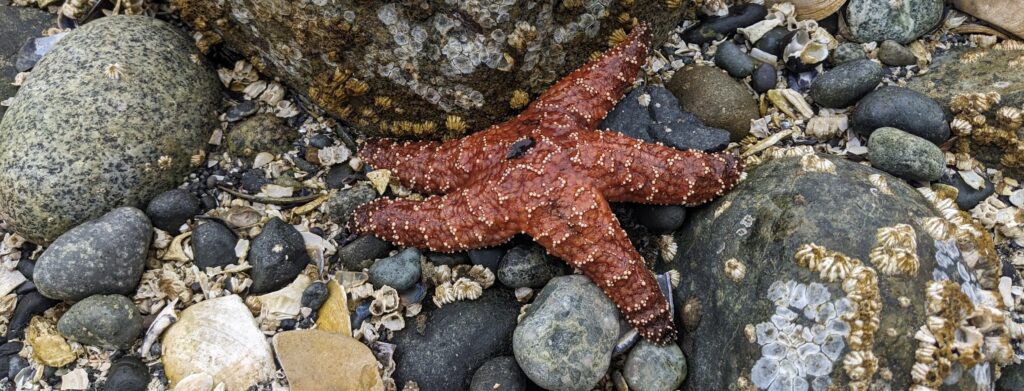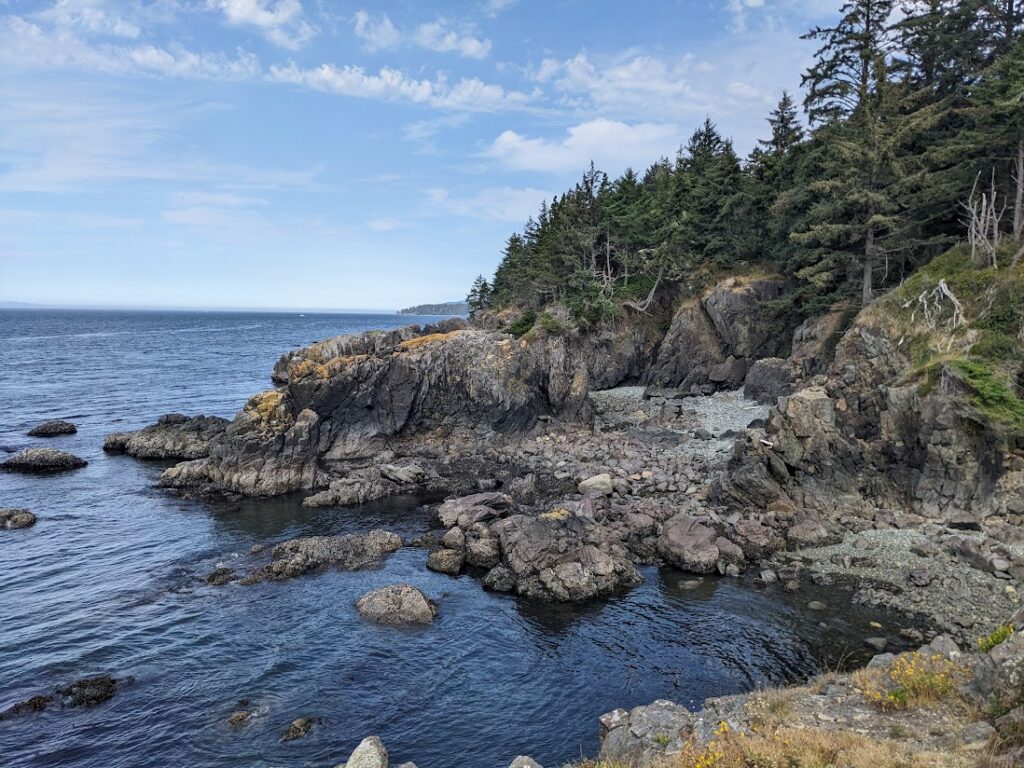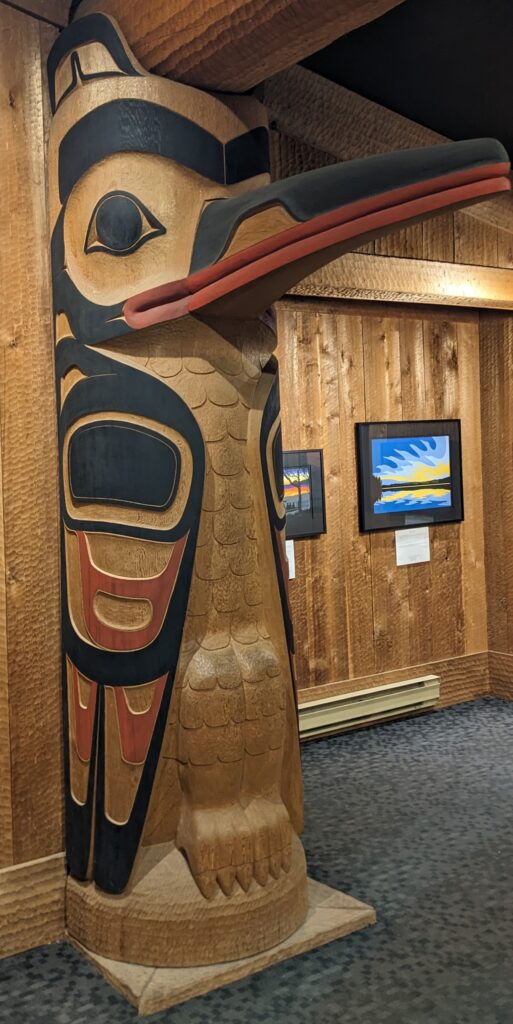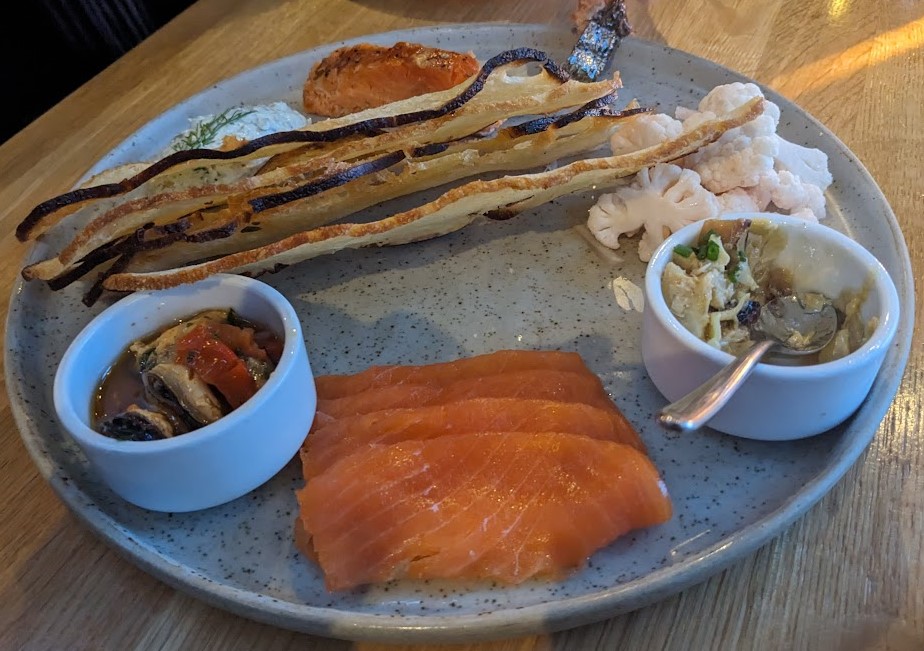
Vancouver Island. An island off the south coast of British Columbia that is 456 km long and 100 km across at its widest point. The population of Vthe island is around 90,000, half of whom live in Greater Victoria on the southern tip of the island. The Brits and the Spaniards arrived in the late 18th century, and squabbled for a while over who would take charge, both countries oblivious to the fact that indigenous peoples had been living there for thousands of years. By the mid-nineteenth century, the Hudson Bay Company had established a fur trading post on the inner harbour of what is now Victoria, (then known as Fort Albert) and today, Victoria is the elegant capital of the province of British Columbia.
A trip to Vancouver Island has been on our ‘to do’ list, for years. However, the ten days we spent there came at the end of a month of travelling across Canada, from east to west, in search of family history and distant cousins. As we hadn’t been sure how much time we would have left at the end, it became rather an ad lib affair. Luckily, despite it being mid-summer and school holidays, we managed to find a couple of great places to stay at the last minute. And at last we set sail across the Salish Sea.
The ferry ride from Vancouver is beautiful, as the ship weavse between the islands in much the same way the American border does. We landed in Swatz Bay and found our way south and east to Nanaimo. After weeks of enervating humidity on the Canadian prairies, the air on the island was crisp and fresh. Decidedly sick of dragging our suitcases about, we renegotiated the notion of a two week road trip. I needed a base, two at a pinch, where I could dump my bags and travel light. I also had a paper to finish for a conference. So, we found an Airbnb on the outskirts of Nanaimo, which gave me a place to plug in my laptop, while the One & Only headed off with his hiking boots to explore.
I didn’t spend the whole time cuddling with my computer, you’ll be glad to hear. I took the weekend off, and we headed across the island to Tofino. Blue skies in the east gave way to cloudy western skies as we drove over the Vancouver Island Ranges. These mountains run north to south along the length of the island, dividing it neatly in two: the west coast is frequently foggy and damp, its rugged outline smothered in pine forests; the east has a drier, more mediterranean climate.
En route, we pull in on the side of the road to visit Cathedral Grove, where we stroll along a boardwalk through the cool and shady old-growth forest of giant Douglas fir trees. Fir trees quickly became the common feature of the whole trip to Vancouver Island. Coastal roads are hedged in by hundreds of Sitka spruce and Douglas firs that effectively block any view of the sea. To reach a beach often meant clambering through dimly lit pine forests, along narrow paths covered in knotted tree roots like varicose veins, and descending down steep staircases of endless, uneven steps.

Luckily, we find it a lot easier to reach Florencia Bay. We park above the beach and stroll along a level path to a short staircase that leads to the shore. Here, the beach curves around the bay for five kilometres, and the bay is scattered with small, rocky islets. Florencia Bay got its name from a ship of that name that capsized off Vancouver Island in 1860 and was wrecked against the rocks.
We scramble across several metres of large grey pebbles that devolve into light grey sand. The sea is grey and uninviting, but the beach is covered in sea-sculpted drift wood, shells and kelp that has drifted in from the dense, offshore forests. Anchored to the sea floor by a ‘holdfast’ – not roots – giant kelp can grow as fast as half a metre a day, and up to 80 metres high. To help it remain upright in the water, each kelp blade or leaf has an air-filled pod that floats, like a small buoy. The kelp strewn along the beach looks like sunbathing triffids with their orb-shaped pods, which burst with a pop more satisfying than bubble wrap. Out at sea they form mats on which the seabirds can rest, and apparently sea otters will wrap themselves in giant kelp to keep from floating away while sleeping.
Lost Shoe Creek, which we have crossed several times on the main road from Port Alberni, finally reaches the sea here. Brilliant name, isn’t it? At the end of the beach, we spy several large rock pools that provide hours of exploring, despite my very poor footwear. Apparently, Florencia Bay can also be a great spot to see dolphins and sea lions. They fail to appear today, but we are perfectly happy with multitudes of sea urchins and fat, happy star fish. As a light rain begins to pock the sand, and the fog drifts in, the empty beach starts to take on a rather eerie atmosphere. We also notice that the tide is coming in surprisingly quickly. It’s time to scuttle back to the cliffs and get out of the rain.
***
In Tofino, we find coffee and a wonderful art gallery, built and owned by Canadian First Nations artist, Roy Henry Vickers. Vickers, the son of a Haida fisherman, began his career as a printmaker, later moving into painting and wood carving. His work blends traditional indigenous art with a contemporary style, that we both find intriguing. Vickers is now something of a national icon, which unfortunately puts most of his glorious paintings beyond our pockets – and the capacity of our cases – but one of his fabulous childrens’ books will make a perfect birthday present for a small girl who is about to turn two…
The One & Only has miraculously managed to find us a night’s accommodation in Tofino, within walking distance of a lovely restaurant on the quay. By now the drizzle has set in with grim determination and shows little sign of abating any time soon, but we are prepared, and don raincoats to potter down the road, dodgling small rivulets and wishing there had been space for our gumboots.
‘Shelter’ provides the perfect haven from the weather. We are greeted by the friendly and enthusiastic staff, who are more than happy to talk us through the menu and trade travel stories. Not surprisingly, the menu consists largely of fish, fish and more fish, with which we are delighted. But where do we start? Will he choose a seafood chowder crammed with a veritable glut of seafood: smoked salmon, surf clams and sockeye salmon, ling cod, clams and gallo mussels? Maybe I will have a Red Thai curry filled with all those same ingredients? Or perhaps just have a simple bowl of Salt Spring Island Mussels?
In the end, we opt for a shared tasting plate – “Taste of the Sound” – with a pretty array of seafood and various accompaniments. There is local salmon, pepper smoked and baked, and Salt Spring Island mussels escabeche. (Escabeche is another name for marinated fish cooked or pickled in lemon juice or vinegar, and flavoured with paprika, citrus, and other spices. Think ceviche or kinilaw.) Then there’s a cauliflower pickle and focaccia toast to dip in a roasted artichoke caponata. I choose a light, lovely unoaked chardonnay from the Okanagan Valley, and sip slowly – for once!
The One & Only can never resist fish and chips, so he is thrilled with two pieces of tempura ling cod and crisp, chunky chips – sorry, fries! – served with a cabbage and kale slaw. I opt for a Tofino surf bowl of local wild salmon and vegetables mixed with teriyaki sauce, sesame jasmine rice, spicy yogurt, cilantro (coriander) and red cabbage. The serving is incredibly tasty, and so generous we will both be able to enjoy the leftovers for lunch tomorrow. If there had been an ounce of room left, I might have succumbed to the chocolate trio of salted caramel pot de crème, espresso mousse cake, and chocolate truffle. Suffice to say, I did not.
***
Another highlight of our time on Vancouver Island is a sunny afternoon on a catamaran, for a spot of whale watching. Eagle Wing Tours leave from Fisherman’s Wharf, and we are accompanied by three wildlife experts who share a running commentary on the marine life we might, and do, see.

Heading out of the harbour, we hear about the Orcas who live hereabouts in small pods all year round. The humpback whales, on the other hand, migrate from Mexico and Southern California, in search of krill, herring and other small bait fish. Heading round the coast, we spot a cormorant posing on a rock, and a pack of seals lazing about on an intertidal ledge, waiting for high tide to feed.
Our guide talks about the sea otters which were virtually extinguished by fur traders, eager to claim their ultra-thick coats. Recently re-introduced from Alaska at Port Renfrew out on the Western Highway past Sooke & Shirley, they are slowly growing in numbers. But only one pup is born at a time – in the water of you don’t mind, so they are born swimming – so it may take some time to significantly build the numbers. River otters, on the other hand, give birth to multiple, smaller pups in a den on the river bank.
We sail around Trail Island and its manned lighthouse, and spot Mount Barker in the distance; a snow-topped mountain across the water in Washington State. We dodge around several huge, ungainly container ships and head out across the Salish Sea towards the coast of the USA.
Apparently, it should be easy to spot a Humpback, as they blow out a spout of water 15-18 feet high when they emerge above the surface. Then the sleek back of the whale and the dorsal fin will follow. When they dive, you might see them flick up their tailfin or fluke. And so, it is. A juvenile male pre-empts his arrival on the surface with a jet of water. Then, his smooth, black, back appears about a hundred metres from the boat. Several times – elegantly, effortlessly – he surfaces and submerges, before his tail flicks up into the air and he dives gently down, leaving barely a ripple. Our guide tells us that the average size of a Humpback male is between 46-49 feet long, a female several feet larger, and they can reach a weight of about 44 tons. Once hunted to the brink of extinction, their numbers are growing steadily.
We watch two Humpback whales that afternoon, but eventually, we must edge away and leave them in peace to feed. As we move on, we pass a small flock of seabirds floating on the water – resting on the kale, I guess – and see several Moon jellyfish pulse by.
Further north, we circle the Race Rocks Ecological Reserve, which consists of a small island, reef and a collection of rocks. Including the surrounding sea, the reserve covers an area of about 620 acres. The rocky island, with its 19th-century lighthouse and keeper’s cottage, is a nesting ground for gulls, oystercatchers, and pigeon guillemots. Easier to spot from the boat than the darting birds, is an assortment of golden Steller and chocolate brown California sealions. The smell, when the wind blows our way, is not the most attractive of aromas, to say the least. They are also surprisingly noisy. One huge Steller sealion is growling ferociously as lesser males try to encroach on his rock. This outcrop is heavily covered with both varieties. There are even a few Harbour seals on the periphery. And most of them are male, seals and sea-lions. It’s what is known as a haulout, when male pinnipeds – seals, sealions and walruses – leave the water to moult or mate, while the female sealions tend to gather separately with their babies in a rookery.

“What is the difference between sealions and ordinary seals?” I ask. Apparently, the Harbour seals are much smaller and less agile on land than sealions. They have shorter, fused fins whereas sea lions have pectoral fins with ball and socket joints and are therefore able to move across land more easily. Seals also have pinholes rather than the visible ears of the sealion. As we are moving away past the lighthouse, someone spots the resident bull elephant seal. Found in the north Pacific, a male can weigh up to four tons and has a strange, trunk-like proboscis, hence its name.
And on that note the catamaran heads for home. And we must too, after a final day driving around the Pacific Marine Circle Route, along the rugged western coastline, lighthouse spotting and plodding through endless evergreen forests, and up to Lake Cowichan where the temperature is 10 degrees warmer and the kids are ‘tubing’ down the river…


